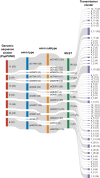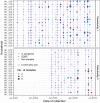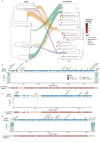Overlapping Streptococcus pyogenes and Streptococcus dysgalactiae subspecies equisimilis household transmission and mobile genetic element exchange
- PMID: 38658529
- PMCID: PMC11043366
- DOI: 10.1038/s41467-024-47816-1
Overlapping Streptococcus pyogenes and Streptococcus dysgalactiae subspecies equisimilis household transmission and mobile genetic element exchange
Abstract
Streptococcus dysgalactiae subspecies equisimilis (SDSE) and Streptococcus pyogenes share skin and throat niches with extensive genomic homology and horizontal gene transfer (HGT) possibly underlying shared disease phenotypes. It is unknown if cross-species transmission interaction occurs. Here, we conduct a genomic analysis of a longitudinal household survey in remote Australian First Nations communities for patterns of cross-species transmission interaction and HGT. Collected from 4547 person-consultations, we analyse 294 SDSE and 315 S. pyogenes genomes. We find SDSE and S. pyogenes transmission intersects extensively among households and show that patterns of co-occurrence and transmission links are consistent with independent transmission without inter-species interference. We identify at least one of three near-identical cross-species mobile genetic elements (MGEs) carrying antimicrobial resistance or streptodornase virulence genes in 55 (19%) SDSE and 23 (7%) S. pyogenes isolates. These findings demonstrate co-circulation of both pathogens and HGT in communities with a high burden of streptococcal disease, supporting a need to integrate SDSE and S. pyogenes surveillance and control efforts.
© 2024. The Author(s).
Conflict of interest statement
The authors declare no competing interests.
Figures





Similar articles
-
Streptococcus dysgalactiae subsp. equisimilis infection and its intersection with Streptococcus pyogenes.Clin Microbiol Rev. 2024 Sep 12;37(3):e0017523. doi: 10.1128/cmr.00175-23. Epub 2024 Jun 10. Clin Microbiol Rev. 2024. PMID: 38856686 Free PMC article. Review.
-
Detection of Streptococcus pyogenes virulence genes in Streptococcus dysgalactiae subsp. equisimilis from Vellore, India.Folia Microbiol (Praha). 2018 Sep;63(5):581-586. doi: 10.1007/s12223-018-0595-2. Epub 2018 Mar 12. Folia Microbiol (Praha). 2018. PMID: 29532420
-
Comparative genome analysis of three Group A Streptococcus dysgalactiae subsp. equisimilis strains isolated in Japan.J Med Microbiol. 2021 Mar;70(3). doi: 10.1099/jmm.0.001322. Epub 2021 Feb 3. J Med Microbiol. 2021. PMID: 33533709
-
Intra-familial transmission of Streptococcus dysgalactiae subsp. equisimilis (SDSE): A first case report and review of the literature.J Infect Chemother. 2022 Jun;28(6):819-822. doi: 10.1016/j.jiac.2022.01.017. Epub 2022 Feb 1. J Infect Chemother. 2022. PMID: 35115237 Review.
-
Integrative genomic, virulence, and transcriptomic analysis of emergent Streptococcus dysgalactiae subspecies equisimilis (SDSE) emm type stG62647 isolates causing human infections.mBio. 2024 Nov 13;15(11):e0257824. doi: 10.1128/mbio.02578-24. Epub 2024 Oct 17. mBio. 2024. PMID: 39417630 Free PMC article.
Cited by
-
Streptococcus dysgalactiae subsp. equisimilis infection and its intersection with Streptococcus pyogenes.Clin Microbiol Rev. 2024 Sep 12;37(3):e0017523. doi: 10.1128/cmr.00175-23. Epub 2024 Jun 10. Clin Microbiol Rev. 2024. PMID: 38856686 Free PMC article. Review.
-
Dissecting the properties of circulating IgG against streptococcal pathogens through a combined systems antigenomics-serology workflow.Nat Commun. 2025 Feb 24;16(1):1942. doi: 10.1038/s41467-025-57170-5. Nat Commun. 2025. PMID: 39994218 Free PMC article.
-
The intricate pathogenicity of Group A Streptococcus: A comprehensive update.Virulence. 2024 Dec;15(1):2412745. doi: 10.1080/21505594.2024.2412745. Epub 2024 Nov 5. Virulence. 2024. PMID: 39370779 Free PMC article. Review.
-
TrexAB, a novel tetracycline resistance determinant in Streptococcus dysgalactiae.Front Cell Infect Microbiol. 2025 Jun 30;15:1583926. doi: 10.3389/fcimb.2025.1583926. eCollection 2025. Front Cell Infect Microbiol. 2025. PMID: 40661965 Free PMC article.
References
Publication types
MeSH terms
Supplementary concepts
Grants and funding
LinkOut - more resources
Full Text Sources
Medical

